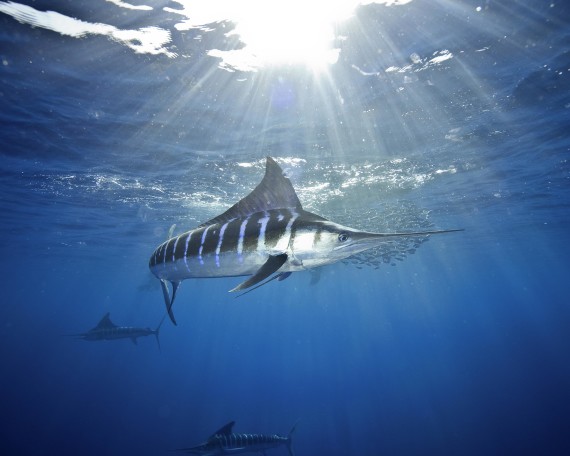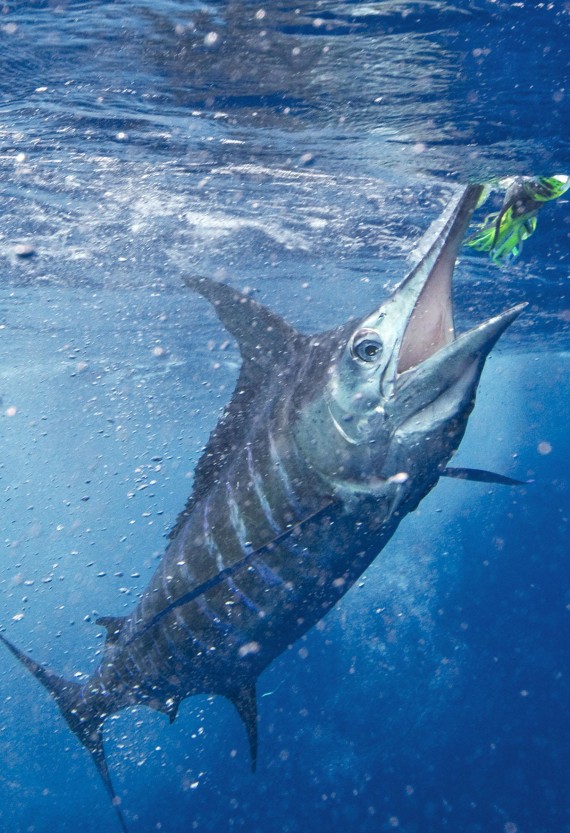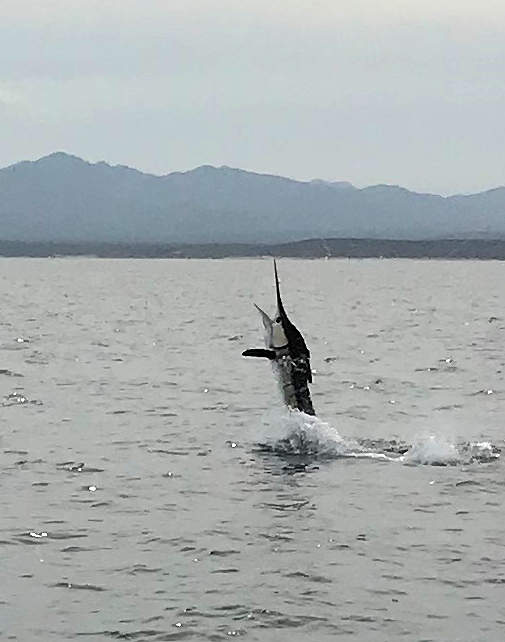Striped Marlin, Kajikia audax
 Striped Marlin, Kajikia audax. Fish caught in coastal waters off Point Palmilla, Baja California Sur, April 2010. Length 1.5 m (4 feet 11 inches). Weight: 34 kg (74 lbs). Catch courtesy Captain Javier and Eduardo Correa, Mexico City.
Striped Marlin, Kajikia audax. Fish caught in coastal waters off Point Palmilla, Baja California Sur, April 2010. Length 1.5 m (4 feet 11 inches). Weight: 34 kg (74 lbs). Catch courtesy Captain Javier and Eduardo Correa, Mexico City.


 Striped Marlin, Kajikia audax. Underwater photographs courtesy of Marc Montocchio (http://www.marcmontocchio.com), Morehead City , North Carolina.
Striped Marlin, Kajikia audax. Underwater photographs courtesy of Marc Montocchio (http://www.marcmontocchio.com), Morehead City , North Carolina.
 Striped Marlin, Kajikia audax. Fish caught off the La Ribera Bank, East Cape, Baja California Sur, January 2018. Catch courtesy of Paul Rousseau, Raleigh, North Carolina. Photograph courtesy of Brad Murakami, Surrey, British Columbia, Canada.
Striped Marlin, Kajikia audax. Fish caught off the La Ribera Bank, East Cape, Baja California Sur, January 2018. Catch courtesy of Paul Rousseau, Raleigh, North Carolina. Photograph courtesy of Brad Murakami, Surrey, British Columbia, Canada.
The Striped Marlin, Kajikia audax, is a member of the Billfish or Istiophoridae Family, that is known in Mexico as marlina rayado. Globally, there are only two species in the genus Kajikia, both found in Mexican waters, one in the Atlantic and one in the Pacific Ocean. Note: this fish has very recently been placed in the Kajikia genus having formerly been known as Tetrapturus audax.
The Striped Marlin has an elongated fairly compressed body. They are dark blue dorsally and silver ventrally with a series of 15 cobalt colored bars made up of round dots and/or narrow bands. Their first dorsal fin is dark blue, their other fins are dark brown, and the bases of their first and second anal fins are tinged with silvery white. Their head has a prolonged slender upper bill with a rounded cross section and relatively small eyes. Their mouth is equipped with small rasp-like teeth on both jaws. They have 2 anal fins, the first with pointed tips and 13 to 18 rays and the second with 5 or 6 rays; both fins are very similar in size and shape to the second dorsal fin. They have 2 dorsal fins; the first with a long base, 37 to 42 rays, and a pointed anterior lobe that is higher in the front and gradually decreases in height toward the rear; the second with 5 or 6 rays and slightly behind the second anal fin. Their caudal fin is deeply forked; their pectoral fins are long and narrow with pointed tips; their pelvic fins are slender and similar in size to the pectoral fins; and there are 2 keels on the side of their tail base. Their body is covered with small elongated bony scales. Their lateral line is visible and curved over the pectoral fins and straight toward the tail base.
The Striped Marlin is the most dominant and widely distributed billfish being an oceanic and epipelagic species that is highly migratory but usually found in coastal environments in tropical and subtropical waters above the thermocline at depths up to 450 m (1,500 feet). Scientifically they have been extensively studied, primarily via satellite tagging, but with mixed results: for example, a “catch and released” fish will behave abnormally for up to two weeks increasing its swimming speed significantly and also migrating very quickly far away from where it was caught. They are a non-schooling species and normally found as solitary individuals except during spawning season. They inhabit the surface at least 85% of the time swimming slowly with their upper caudal fin lobe above the surface and their dorsal fin retracted; this allows them to be visually distinguished from the swordfish, which have locked upright dorsal fins. They are only be found in waters with temperatures between 20oC (68oF) and 25oC (77oF). They reach a maximum of 3.5 m (11 feet 6 inches) in length being dimorphic with females being larger than males. As of January 1, 2024, the International Game Fish Association world record stood at 224 kg (494 lbs) with the fish caught in coastal waters off New Zealand in January 1986. A Striped Marlin Weight from Length Conversion Table has been included in this website to allow the accurate determination of fish weight from length so these fish can be returned to the ocean unharmed (strongly recommended). They compete for the same food as other billfish, dorados, large sharks, large tuna, and wahoo. They are carnivorous and non-selective feeders stunning their prey with their elongated bill; they feed primarily on anchovies, cornetfish, jacks, mackerels, sardines, and squid. Once mature they are generally free from predation by other fish. Reproduction is via pelagic eggs. Juveniles are fast growing and seldom seen by humans. They have a lifespan of more than ten years.
The Striped Marlin is a resident of all Mexican waters of the Pacific Ocean with the exception that they are absent from of the northern Sea of Cortez.
The Striped Marlin is most likely confused with the Blue Marlin, Makaira nigricans (blue coloration; dorsal height less than body depth; gradated first dorsal fin).
The Striped Marlin is a highly prized targeted big game species, primarily due to their abundance, phenomenal acrobatic aerial displays when hooked, and strong stamina. The quality of the flesh is marginal but is the best of the billfish. They are marketed fresh and frozen, and utilized primarily for sashimi and sushi. Catch rates are on the order of 10,000 to 15,000 tons per year with the majority of fish caught as a by-catch of commercial longliners targeting tuna who may use as many as 2,000 hooks in one string. There are approximately 12,000 Striped Marlins caught annually in the greater Los Cabos area by sports fishermen, the majority of which are 3 to 6 years old and weigh between 47 kg (120 lbs) and 79 kg (200 lbs). From a conservation perspective the Striped Marlin is currently considered to be NEAR THREATENED with their populations is now in decline. To date very few global conservation measures have been put in place.
A word of caution: these fish are ginormous wild animals and their spears are very dangerous!